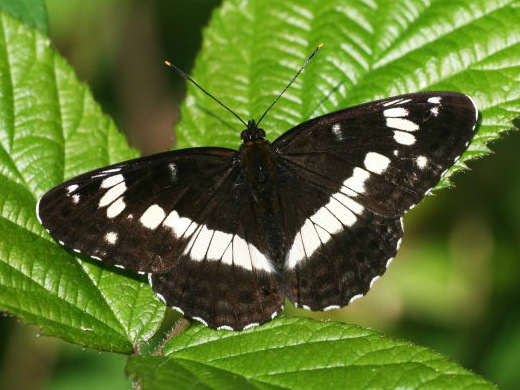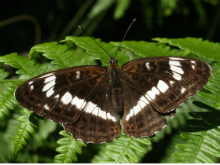
| Butterfly Conservation |
 |
| Hertfordshire & Middlesex Branch |
 |
|
|||
| Saving butterflies, moths and our environment | ||||


White AdmiralLimenithis camillaLocal in woodland Distribution and Status In the 1980s the White Admiral occurred in a number of the larger woods in Hertfordshire like the Broxbourne Woods complex and in the west, Bricket Wood Common and the Ashridge area near Tring. By end of the 1990s however, many of the colonies in the west of the county died out and the main colonies were now in the Broxbourne area. Reports were now coming from the Ruislip Woods complex in Middlesex. The 2000s, perhaps aided by the warmer summers in 2003 and 2006, brought about a small expansion of this species so that it is now seen in more tetrads in Hertfordshire as well as in north-west Middlesex Habitat Requirements Deciduous woodlands where its hostplant Honeysuckle Lonicera periclymenum grows in shady situations but sunlit rides are required for males establishing territories Larval Foodplants Honeysuckle Lonicera periclymenum Adult Food Sources Bramble Rubus fruticosus agg., Ergot (fungus), Ground/mud/road surface Behaviour/Observation notes Although the White Admiral spends some time in the tree canopy like the Purple Emperor, males often fly at lower levels in sunlit rides. Both sexes will occasionally come down to feed. If you know where to find the butterfly, with some patience you may be lucky to find it basking or feeding on flowering brambles with its wings wide open to provide good photographic opportunities Life History Usually only one generation a year is produced with emergence from the middle of June until the end of July. A partial second brood is sometimes produced in warm summers as in 2006. Females lay eggs singly on the upperside of a honeysuckle leaf in slightly shady situations. Larvae feed on the tip and sides of a midrib of a leaf before forming a hibernaculum for the winter. Feeding is resumed in the spring. When fully grown, a pupa is formed suspended from a leaf or stem Further information
More on life cycle and status |
Copyright Butterfly Conservation © 2019 Hertfordshire & Middlesex Branch
Privacy and Copyright Statement and Cookie Policy Statement
Butterfly Conservation
Company limited by guarantee, registered in England (2206468)
Registered Office: Manor Yard, East Lulworth, Wareham, Dorset, BH20 5QP. Tel: 01929 400 209
Charity registered in England & Wales (254937) and in Scotland (SCO39268). VAT No. GB 991 2771 89